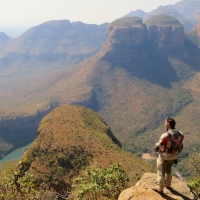 After a nice time in Zambia, we ride on and cross the border to Zimbabwe today at the Victoria Falls. After completing the formalities on the Zambian side we drive over the old railway bridge across the gorge to the neighboring country. From the bridge we catch just a glimpse of the spectacular waterfalls before the spray covers our sunglasses. The paperwork in Zimbabwe takes a lot longer, but after an hour we have all the stamps we need. We can hit the road.
After a nice time in Zambia, we ride on and cross the border to Zimbabwe today at the Victoria Falls. After completing the formalities on the Zambian side we drive over the old railway bridge across the gorge to the neighboring country. From the bridge we catch just a glimpse of the spectacular waterfalls before the spray covers our sunglasses. The paperwork in Zimbabwe takes a lot longer, but after an hour we have all the stamps we need. We can hit the road.
At the border we not only fill our motorbikes with fuel, but also our money pouches with American dollars. Zimbabwe has recently switched to the American currency because the Zimbabwean dollar was worthless. For a bread you had to put down as much as a few million! We can use the American dollars, because they are accepted almost everywhere. Even by the Tanzanian police. Very convenient that they just come from the ATM here.
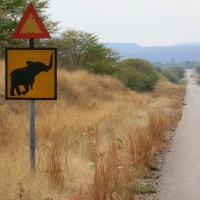 Although we have heard good stories about Zimbabwe from other tourists, we limit our visit to this country to two long days on the main highway. This then gives us more time to travel through South-Africa before we settle down at the campsite near Cape Town (as the owners of the campsite go on holiday). We leave the hotels and souvenir shops at Victoria Falls behind us and ride almost immediately in the African bush. As far as we can see, we look out over a dense forest with a long straight asphalt road splitting it in half. Along the road are signs that warn for elephants, antelopes and even wild dogs, but today we have no time to look for wildlife. We just drive at a steady speed, listing to some music.
Although we have heard good stories about Zimbabwe from other tourists, we limit our visit to this country to two long days on the main highway. This then gives us more time to travel through South-Africa before we settle down at the campsite near Cape Town (as the owners of the campsite go on holiday). We leave the hotels and souvenir shops at Victoria Falls behind us and ride almost immediately in the African bush. As far as we can see, we look out over a dense forest with a long straight asphalt road splitting it in half. Along the road are signs that warn for elephants, antelopes and even wild dogs, but today we have no time to look for wildlife. We just drive at a steady speed, listing to some music.
We hardly see any people, livestock, villages or other traffic all day. That changes abruptly as we enter Bulawayo at the end of the day. It is a big city with four million inhabitants. We suddenly drive between high buildings, along beautiful residential areas and busy shopping streets. What a difference! We camp at a campsite in the centre and get back on the bikes again early next morning for another long journey towards the south. And as abruptly as the city began, it ends. We are less than 15 minutes on the road when we again drive through the forest. Miles around no people or animals in sight.
 There are almost no fuel stations along the route and if there exist, they do not always have fuel. We use the ’fill-wherever-you-can-method’, even when this means we only take 5 litre per bike. But even now we do not always make it to the next fuel station. We need to refill the tank from our spare jerrycans several times.
There are almost no fuel stations along the route and if there exist, they do not always have fuel. We use the ’fill-wherever-you-can-method’, even when this means we only take 5 litre per bike. But even now we do not always make it to the next fuel station. We need to refill the tank from our spare jerrycans several times.
At the beginning of the afternoon we arrive at Beitbridge on the border with South Africa. We must first get our stamps on the Zimbabwean side. It is busy and there are long lines of people. It is not immediately clear where we have to go and what documents they want to see. We choose one of the rows, but are sent back when we reach the counter, because we first have to fill in some forms. We finally get a stamp in our passport at the first counter and a stamp in our carnet at the second counter. At the third window we pay taxes and with the receipt we receive another stamp from the police officer in the corner. It takes quite a long time, but we had already expected that the Zimbabwean side would not go that fast. In South Africa, this will probably be a lot more efficient.
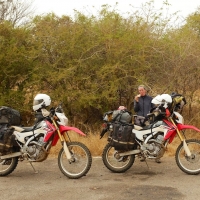 We leave Zimbabwe and park on the South African side a few hundred meters away. To our surprise, it is much busier on this side of the border. With our papers in our hand, we look for the right counter until we find out that we should not be in the building, but go to the temporary counters that are put up outside. Apparently this border crossing is very busy with immigrants from the surrounding countries that come to South-Africa to look for a job. There are at least 100 people waiting in queues at the counters. From the facial expressions of the people waiting it seems like they have been here for a while already. We go in one of the lines and move forward a little bit until our counter closes with a bang. Around us people are beginning to grumble restlessly. It it no use to go into a different line because they are even longer, so we keep our own line just like the people in front of us. After fifteen minutes the counter opens again. The lady behind the counter wipes her mouth and looks like she has enjoyed her late lunch. The line slowly moves forward again.
We leave Zimbabwe and park on the South African side a few hundred meters away. To our surprise, it is much busier on this side of the border. With our papers in our hand, we look for the right counter until we find out that we should not be in the building, but go to the temporary counters that are put up outside. Apparently this border crossing is very busy with immigrants from the surrounding countries that come to South-Africa to look for a job. There are at least 100 people waiting in queues at the counters. From the facial expressions of the people waiting it seems like they have been here for a while already. We go in one of the lines and move forward a little bit until our counter closes with a bang. Around us people are beginning to grumble restlessly. It it no use to go into a different line because they are even longer, so we keep our own line just like the people in front of us. After fifteen minutes the counter opens again. The lady behind the counter wipes her mouth and looks like she has enjoyed her late lunch. The line slowly moves forward again.
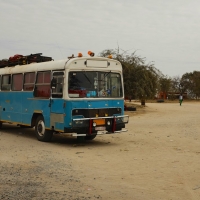 At the counter, we see different people handing a yellow form. It turns out that you have to fill that form in when you cross the border with your own vehicle. A document we then also need. To avoid being turned away at the counter a second time that day, I follow the example of others and walk to the beginning of the line to ask for a form. The lady takes her time to address my question after which she helps the next customer. No wonder it takes so long. After more than an hour, we finally get stamps in our passports.
At the counter, we see different people handing a yellow form. It turns out that you have to fill that form in when you cross the border with your own vehicle. A document we then also need. To avoid being turned away at the counter a second time that day, I follow the example of others and walk to the beginning of the line to ask for a form. The lady takes her time to address my question after which she helps the next customer. No wonder it takes so long. After more than an hour, we finally get stamps in our passports.
Now we just have to import the motorbikes into South Africa. As we walk back to the office, we see a man walking round our motorbikes, taking pictures with his phone. We go to him and meet John from Johannesburg. He is now on a business trip, but has travelled a fair bit on his bikes in the past. We talk about the bikes, about our trip and the places we want to visit in South Africa. He looks startled when he hears that we want to go to Johannesburg and advises us not to go there. It would be too dangerous for tourists. We had already heard rumors about Johannesburg, but had taken that to be over-exaggerated. We had a great time in ‘Nairobbery’, so how bad could Johannesburg be? But once we get started on this, he again urges us to skip Johannesburg because it really is not safe. He hands over his business card. If we really want to go to Johannesburg, we can stay with him. According to John, that is much safer than just somewhere in a hotel.
 Once he understands that we do not have all of our stamps yet, he takes us inside to the right counter where he ensures that our carnets are stamped within five minutes. After he again says we should not go to his hometown we say goodbye and we get back on the bikes again.
Once he understands that we do not have all of our stamps yet, he takes us inside to the right counter where he ensures that our carnets are stamped within five minutes. After he again says we should not go to his hometown we say goodbye and we get back on the bikes again.
Still a bit confused by the urgent warnings of John we enter South Africa. We had already heard about the crime in South Africa, but how bad can it be? You could say that we have already seen some dodgy places.
While we drive on the highway towards Musina, we see road signs with the text; “High crime zone. Do not stop”. The warning is repeated every few kilometres. It gives me an awkward feeling, we have not seen this anywhere else in Africa. We drive in one go to the center of Musina to look for a place to stay. And even when we enter the town, we are warned not to stop because of the risk of being robbed. What is this all about? We will really have to stop at stop point to find a room. And that appears to be less simple than we thought. The hotels we go to are very expensive, full or have no safe parking. Although this is not the first time it takes a bit longer to find a bed, the quest causes a lot of stress this time. Whenever the GPS wants to send us in a certain direction, we wonder whether it is safe.
 At dusk we arrive at Musina Backpackers, the last option. When the gate opens, we see a broadly smiling man who literally opens his arms to welcome us. We park our motorbikes and meet the South African Johan and his Bulgarian wife, Anna. Johan takes us to one of the rooms while Anna poors us a drink. Great, we have a bed.
At dusk we arrive at Musina Backpackers, the last option. When the gate opens, we see a broadly smiling man who literally opens his arms to welcome us. We park our motorbikes and meet the South African Johan and his Bulgarian wife, Anna. Johan takes us to one of the rooms while Anna poors us a drink. Great, we have a bed.
When we ask them whether those warnings were necessary, they both confirm that those signs are there for a reason. If we tell that we want to do some shopping, Johan looks at his watch worried. He says that we still have 45 minutes to walk to the mall, because after that the sun will go down and then it is no longer safe on the streets for ’whites’. He pronounces the last few words whispering. I cannot hide my surprise and look at him in silence. We decide to follow his advice and make sure we are back inside the gate of the hostel before sunset.
 Once back at the hostel, we have a beer with Johan and Anna. They give us a crash course on South Africa and tell us about the history, the current political situation, the abolished apartheid and the (in)security. Although they are also excited to tell us what wonderful places we can visit during our trip through South Africa, I feel weird when I crawl into bed that night. I had thought that we had arrived in a developed Western country where we would be able to travel comfortably without any difficulties. Instead, we start the trip at one of the most chaotic border crossing so far, in a dangerous border town where we have to fear for our lives after dark. It seems to be the wild west here! For the first time this entire trip I am afraid. In South Africa of all places!
Once back at the hostel, we have a beer with Johan and Anna. They give us a crash course on South Africa and tell us about the history, the current political situation, the abolished apartheid and the (in)security. Although they are also excited to tell us what wonderful places we can visit during our trip through South Africa, I feel weird when I crawl into bed that night. I had thought that we had arrived in a developed Western country where we would be able to travel comfortably without any difficulties. Instead, we start the trip at one of the most chaotic border crossing so far, in a dangerous border town where we have to fear for our lives after dark. It seems to be the wild west here! For the first time this entire trip I am afraid. In South Africa of all places!
We stay at Musina Backpackers the next day to take care of some administrative matters and then put our stuff on the bikes again. We say goodbye to Johan and Anna and ride off into the big bad South Africa. We both cannot imagine that it is really as bad with the (in)security as everyone says. We decide to listen carefully to the warnings and to stay alert as we always do, but also to keep travelling the way we have done so far.
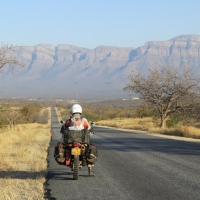 From Musina we first follow the highway south for a while. Just before Polokwane we take a turn and drive on backroads through Tzaneen towards Hoedspruit. It is winter in South Africa and in this part of the country that means that it is very dry. The fields are golden yellow and are beautiful against the bright blue sky. At the end of the day we see a mountain ridge called Klein Drakensberg in the distance. The sun is already low in the sky and makes beautiful shadows on the sharp-shaped hill. We pitch our tent at a campsite in Hoedspruit. Once the sun has set, it cools off considerably. It is so chilly that we take our cooking gear to the communal kitchen and spend the rest of the evening inside.
From Musina we first follow the highway south for a while. Just before Polokwane we take a turn and drive on backroads through Tzaneen towards Hoedspruit. It is winter in South Africa and in this part of the country that means that it is very dry. The fields are golden yellow and are beautiful against the bright blue sky. At the end of the day we see a mountain ridge called Klein Drakensberg in the distance. The sun is already low in the sky and makes beautiful shadows on the sharp-shaped hill. We pitch our tent at a campsite in Hoedspruit. Once the sun has set, it cools off considerably. It is so chilly that we take our cooking gear to the communal kitchen and spend the rest of the evening inside.
After a refreshing night we ride up the hills the next day. Now the sun is back, it is a lovely day for a ride. We drive past fields full of fruit trees and then follow several hairpin bends and tunnels to a high plateau. We stop at a lookout point from where we can see the Blyderivier Canyon. The view of the 800 meter deep canyon is magnificent!
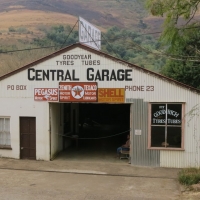 From the gorge we drive a scenic route with delicious curves to the village Pilgim’s Rest. The village was founded in 1875 when gold was discovered in the area and has changed little since that time. The ‘Halfway House’ where weary travellers could take a rest halfway their journey is still in perfect condition, just like the old garage and the characteristic homes. It is as if time stood still and it is not difficult to imagine how wagons used to ride through the streets or how horses would stand outside the bar waiting for their owner.
From the gorge we drive a scenic route with delicious curves to the village Pilgim’s Rest. The village was founded in 1875 when gold was discovered in the area and has changed little since that time. The ‘Halfway House’ where weary travellers could take a rest halfway their journey is still in perfect condition, just like the old garage and the characteristic homes. It is as if time stood still and it is not difficult to imagine how wagons used to ride through the streets or how horses would stand outside the bar waiting for their owner.
From Pilgrim’s Rest we drive over the golden hills. It is very beautiful. We stop at every turn to take pictures or just to enjoy the view. In the valley it was still sunny but as soon as we are a little further up the hill we see the clouds in the distance. Only a few moments later we ride in thick fog. We stay behind a well-lit truck, because overtaking it would be madness. The temperature difference is huge. That morning we had left with extra warm clothing, but now we also turn on the heated grips. We cannot even remember the last time we used those. It is clear that it is winter.
 That night, we stay in Nelspruit with a South African family that has converted their house into a hostel. Our tent stands in the garden and as always gives the feeling of being ’at home’. The next morning we leave with even more clothes on in the direction of Newcastle. We avoid the highway and drive along backroads to the south-west. We drive along endless gold coloured fields, with only here and there a farm. The next farm is sometimes 20 kilometres away, which you will never see in the Netherlands. They are without doubt emigrants from the Netherlands who have founded the villages in this part of Africa, because we pass ’Dutch towns’ such as Ermelo, Amersfoort, Morgenzon, Familiehoek and even Amsterdam.
That night, we stay in Nelspruit with a South African family that has converted their house into a hostel. Our tent stands in the garden and as always gives the feeling of being ’at home’. The next morning we leave with even more clothes on in the direction of Newcastle. We avoid the highway and drive along backroads to the south-west. We drive along endless gold coloured fields, with only here and there a farm. The next farm is sometimes 20 kilometres away, which you will never see in the Netherlands. They are without doubt emigrants from the Netherlands who have founded the villages in this part of Africa, because we pass ’Dutch towns’ such as Ermelo, Amersfoort, Morgenzon, Familiehoek and even Amsterdam.
That night we have more difficulty finding a place to sleep. After the first campsite turns out to be full, we now follow the GPS to the town of Volksrust where another campsite should be. Just outside the city centre, we indeed find a sign which refers to the “4×4 Avonture Camping”. We take the turn and follow the signs until we drive into the yard of a farm after a few kilometers. The house stands in a beautiful place, in the curve of the surrounding hills with stunning views over the meadows. We ring the bell, but nobody is home. Also, the phone number that is on the door is not answered. Too bad, because it is almost dark so proceeding to the next village does not seem to be an option.
 Then we hear a voice. From one of the meadows comes a group of cows that are being encourages to walk into the barn by a farmhand. He barely speaks English or Afrikaans, but he does make clear that the boss is not at home. He points to the hills behind the house and explains that the campsite is there. It seems pretty far away and although we do not know how challenging the 4×4 trail is, we decide to drive there anyway. We have to sleep somewhere.
Then we hear a voice. From one of the meadows comes a group of cows that are being encourages to walk into the barn by a farmhand. He barely speaks English or Afrikaans, but he does make clear that the boss is not at home. He points to the hills behind the house and explains that the campsite is there. It seems pretty far away and although we do not know how challenging the 4×4 trail is, we decide to drive there anyway. We have to sleep somewhere.
It appears to be a proper off-road trail, with water crossings, deep ruts, muddy turns and steep slopes with loose stones. But our bikes are like mountain goats and can get anywhere without any problems. At some point when we are halfway up the hills we arrive at a beautiful campground with sheltered places among low bushes. We are the only ones there. On one of the spots a fire is still smoldering. That is a good thing, because it is pretty chilly. While Peter pitches the tent, I collect wood to make a fire and I start to cook. By the time the food is ready, the sun has already disappeared behind the horizon for some time. It is now very cold. 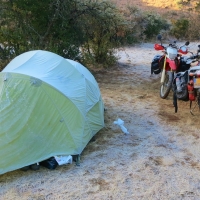 While we are almost in the fire to keep warm, we eat our food standing. We quickly brush our teeth, dare to visit the cold toilet and then quickly crawl into the tent. We have very thick sleeping bags, with an added sheet, but today we both also wear socks, long trousers and a t-shirt with long sleeves. We do not even take off our woolen hat. We have not been so cold yet during the whole trip!
While we are almost in the fire to keep warm, we eat our food standing. We quickly brush our teeth, dare to visit the cold toilet and then quickly crawl into the tent. We have very thick sleeping bags, with an added sheet, but today we both also wear socks, long trousers and a t-shirt with long sleeves. We do not even take off our woolen hat. We have not been so cold yet during the whole trip!
The next morning it takes a lot of effort to leave the warm sleeping bag and to put on the cold clothes. I am putting on every bit of warm clothing I have; long underwear, shirt, t-shirt, long sleeve, a woolen sweater, a scarf, a windproof jacket and then mu motorcycle gear and thick socks. The tent and the bikes are covered in a thick layer of white ice. The fire is still smoldering and with some new wood it burns in no time. I go to fetch water for the coffee, but all the water lines are frozen. With the last bit of water that we have, we make coffee and for breakfast we heat up a can of baked beans in tomato sauce. It seems like the right breakfast in these surroundings. Like the night before we eat our food while standing close to the fire. When the sun finally shines over the hills, the ice begins to melt.
 Once everything is packed, we follow the path back to the farm. There is still nobody home. The farmhand waves us goodbye and continues his work. We drive off the yard and continue our trip to the south-west. The area is really beautiful with vast yellow plains and beautiful rock formations that look like the pictures we have seen of Monument Valley in the United States. It is like we have ended up in the wild west and cowboys and Indians will appear any moment. By now the wild country does give me a slightly more secure feeling than when we just entered South Africa.
Once everything is packed, we follow the path back to the farm. There is still nobody home. The farmhand waves us goodbye and continues his work. We drive off the yard and continue our trip to the south-west. The area is really beautiful with vast yellow plains and beautiful rock formations that look like the pictures we have seen of Monument Valley in the United States. It is like we have ended up in the wild west and cowboys and Indians will appear any moment. By now the wild country does give me a slightly more secure feeling than when we just entered South Africa.
From the top of one of the hills we have a wonderful view over the Drakensberg, the mountain range that forms the border with the mini-country Lesotho. We had wanted to go there, also to ride the Sanipas. But winter has overtaken us and the possibility that we end up in the snow when we go to Lesotho is too big. Instead, we drive along the mountain range to the south and we pitch our tent at Amphitheatre Backpackers that night. From the campsite, we have a beautiful view over the cliffs and the yellow meadows with large herds of cows. Again, it is very cold. After an almost magical sunset we crawl in our sleeping bags. This time with an extra blanket we got on loan form the receptionist.
Distance travelled to Amphitheatre Backpackers in Bergville: 23.663km (14.703 miles)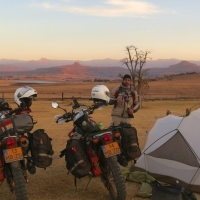
Previous story “The smoke that thunders” – Next story “‘Adventure’ in all shapes and sizes“





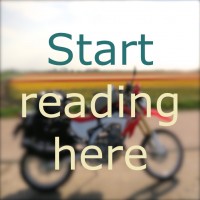


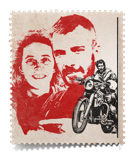
BRRRRRR mooi verhaal.Warme knuffels!
Beste Peter en Leonie,
Ook wij genieten nog steeds van jullie unieke verhalen! Leuk om op deze manier met jullie mee te reizen. Janleen en Joke
Leonie en Peter, het is zo leuk om jullie
verhalen te lezen! Zo gaaf!
Gr Nadine Luijken